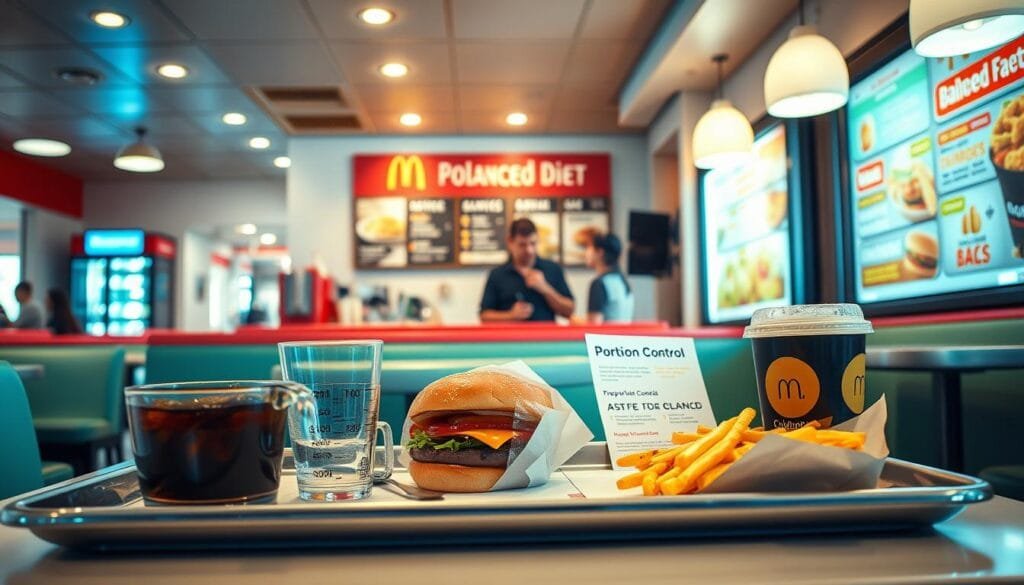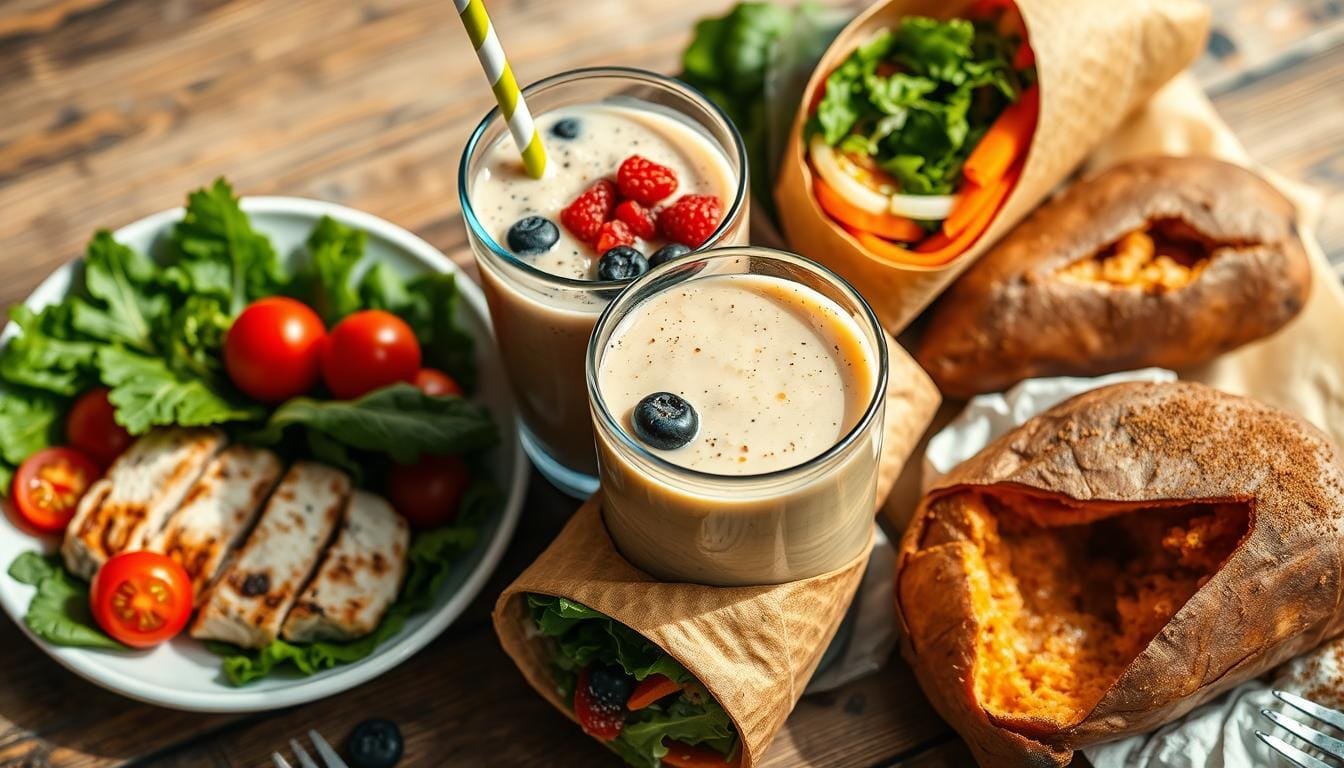Fast food can be a convenient option, but it often comes with high calories, sodium, and fat. As someone who occasionally relies on fast food, I’ve learned how to eat healthy when eating fast food to maintain a balanced diet.
Experts like Julia Zumpano and Kate Patton highlight the challenges of finding nutrient-dense options in fast food menus. Despite these challenges, there are ways to make healthier selections without sacrificing taste.
In this article, I’ll share strategies for navigating fast food menus, including portion control and nutritional swaps. By being informed and mindful, you can enjoy fast food while keeping your diet on track.
Key Takeaways
- Fast food can be part of a balanced diet with mindful choices.
- Opt for grilled options instead of fried to reduce fat intake.
- Choose smaller portions to control calorie and sodium consumption.
- Customize your meal by swapping high-calorie toppings and sauces.
- Incorporate vegetables and lean proteins into your fast food meals.
Exploring Nutritional Challenges at Fast Food Restaurants
Fast food is a popular choice for many due to its convenience, but it often presents significant nutritional challenges. Many fast food meals are high in calories, fat, and sodium, which can make maintaining a balanced diet difficult.
Understanding Calories, Fat, and Sodium Loads
A typical fast food meal can be quite calorie-dense. For example, a burger, fries, and a soda can easily exceed 1,000 calories, which is nearly half of the recommended daily intake for many adults. Such high calorie counts can lead to consuming more calories than needed in a single meal.
Fat content is another concern. Many fast food items are high in saturated fats, which can increase cholesterol levels and heart disease risk. For instance, a chicken sandwich might sound healthier but could contain high levels of saturated fat, especially if breaded and fried.
| Fast Food Item | Calories | Fat (g) | Sodium (mg) |
|---|---|---|---|
| Cheeseburger | 300-400 | 10-15 | 800-1000 |
| French Fries (medium) | 200-300 | 8-12 | 350-500 |
| Chicken Nuggets (6 pieces) | 250-350 | 12-18 | 400-600 |
The Lack of Nutrient-Dense Foods
Another challenge is the scarcity of nutrient-dense options. While some restaurants offer salads or grilled chicken, these items often come with high-calorie dressings or sauces. Additionally, sides like fries or onion rings are typically high in fat and sodium.
Vegetables and whole grains are often limited on fast food menus. When they are available, they might be prepared in ways that negate their health benefits, such as frying or adding excessive cheese or cream.
Understanding these nutritional challenges is the first step toward making better choices. By being aware of what you’re consuming, you can navigate the menu more mindfully and select options that align with your dietary goals.
How to Eat Healthy When Eating Fast Food
Making healthier choices at fast food restaurants is easier than you think. By focusing on smart swaps and being mindful of what you order, you can enjoy your meal without derailing your dietary goals.
Smart Swaps and Lean Protein Options
One of the simplest ways to improve your fast food meal is by swapping high-calorie items for better alternatives. For example, choosing a grilled chicken sandwich instead of a fried one can save you around 200 calories and 10 grams of fat. Opting for a smaller burger, like a single patty, instead of a double or triple, also helps keep your calorie intake in check.
Don’t forget to customize your order. Removing high-fat toppings like cheese or mayo and skipping sauces can significantly reduce your meal’s calorie and fat content. For sides, consider swapping fries for a salad or fruit cup. These small changes add up and make a big difference in the overall nutritional profile of your meal.
Reading Nutritional Information Effectively
Understanding the nutritional information provided by fast food restaurants is key to making informed choices. Most restaurants now display calorie and sodium counts on their menus or online, making it easier to compare options.
Aim for meals that fall between 400 to 600 calories, and keep an eye on sodium levels. For example, a grilled chicken sandwich typically has around 300 calories and 6 grams of fat, while a cheeseburger can range from 400 to 600 calories and 15 to 25 grams of fat. Being mindful of these numbers helps you stay within your daily limits.
| Fast Food Item | Calories | Fat (g) | Sodium (mg) |
|---|---|---|---|
| Grilled Chicken Sandwich | 300-400 | 6-8 | 600-800 |
| Cheeseburger | 400-600 | 15-25 | 800-1000 |
| Medium Fries | 200-300 | 8-12 | 350-500 |
By making a few simple swaps and paying attention to nutritional information, you can enjoy fast food while keeping your diet balanced and nutritious.
Smart Ordering Tips & Customizing Your Meal Choices
Planning ahead is key to making smarter choices when it comes to fast food. By reviewing menu guides before heading out, I can avoid high-calorie surprises and make informed decisions that align with my dietary goals.
Planning Ahead with Menu Guides
Checking nutritional guides online helps me identify better options. For instance, opting for a grilled chicken sandwich instead of a fried one can save around 200 calories and 10 grams of fat. I also look for smaller portions and avoid supersized combos, which often add unnecessary calories and sodium.
Special Requests and Healthier Substitutions
Customizing my order makes a big difference. I ask for sauces on the side and swap fries for a salad or fruit cup. Adding extra veggies or holding condiments like mayo can significantly improve the meal’s nutritional value. For example, choosing a whole-grain bun or selecting a sandwich without cheese reduces fat and calorie intake without sacrificing flavor.
By being proactive and making informed choices, I can enjoy fast food while maintaining a balanced diet. These strategies have personally helped me make healthier decisions without compromising on taste.
Navigating Menus and Portion Control at Fast Food Chains
Navigating fast food menus requires a strategic approach to avoid overconsumption of calories and fats. One common pitfall is supersized meals, which often lead to eating more than needed. These larger portions can quickly add up, making it harder to stay within daily calorie goals.
Avoiding Oversized and Supersized Meals
Supersized meals are designed to offer more value, but they often come with excessive calories and sodium. For example, a large fries and soda combo can add hundreds of calories to your meal. Opting for regular or small sizes helps keep portions in check, making it easier to maintain a balanced diet.
Utilizing Children’s Menus for Smaller Portions
Children’s menus can be a great option for those looking for smaller portions. Items like smaller burgers or chicken tenders are often satisfying without the extra calories. I personally use children’s menus to enjoy my favorite foods in moderation, which helps me avoid overeating without sacrificing flavor.

Research shows that portion control is key to managing calorie intake. By choosing smaller options and avoiding supersized meals, you can enjoy fast food while keeping your diet on track. Understanding portion sizes and making mindful choices makes fast food a viable option for occasional meals.
Exploring Healthy Options Across Different Cuisines
Fast food options vary widely across cuisines, offering a range of choices that can fit into a balanced diet. While traditional items are often high in calories and fat, many chains now provide healthier alternatives. By exploring these options, you can enjoy fast food without compromising your dietary goals.
Healthier Choices at Burger and Chicken Restaurants
Burger and chicken restaurants often feature grilled options that are lower in fat. For instance, a grilled chicken sandwich can be a good choice, offering lean protein without the extra fat of fried items. Some chains also offer plant-based burgers, which can be lower in saturated fat and calories.
Smart Orders at Mexican, Sandwich, and Pizza Chains
Mexican chains like Chipotle offer burrito bowls with lean meats and extra veggies, avoiding heavy tortillas and sour cream. Sandwich shops such as Subway provide six-inch subs on whole-grain bread with reduced-fat condiments. For pizza, thin-crust versions with vegetable toppings and light cheese are better options.
Considering Asian and Other Fast Food Alternatives
Asian fast food often includes steamed rice and stir-fried vegetables, which are healthier than fried noodle dishes. These options provide essential nutrients and fiber, making them a good choice for a balanced meal.
Exploring these healthier alternatives can make a significant difference in your diet. By choosing wisely across different cuisines, you can enjoy fast food while maintaining a healthy balance.
Beverage, Sides, and Smart Condiment Selection
When it comes to fast food, what you drink and the sides you choose can greatly impact the overall healthiness of your meal. These often-overlooked elements can either enhance or detract from your dietary goals.

Choosing Low-Calorie Drinks and Avoiding Sugary Beverages
Drinks can add a significant number of calories to your meal. For instance, a large soda can add over 200 calories. I opt for water or unsweetened tea instead of sugary beverages to keep my calorie intake in check.
Shakes and sweetened drinks are also high in calories and sugar. A chocolate shake can range from 800 to 1,200 calories, which is more than a meal’s worth of calories. Sticking to low-calorie options helps maintain a balanced diet.
Healthy Sides vs. Fried Options
Fried sides like fries are high in fat and calories. A medium serving of fries can add around 300-400 calories. Instead, I choose side salads or fruit cups, which are lower in calories and richer in nutrients.
Some restaurants offer alternatives like apple slices or a side of steamed vegetables. These options not only reduce calorie intake but also provide essential vitamins and fiber.
Smart Condiment Choices
Condiments can add hidden calories and fat. For example, mayo adds around 90 calories per tablespoon. I prefer using mustard, which is lower in calories, to add flavor without the extra fat.
When it comes to sauces, less is better. I ask for them on the side and use them sparingly. This small change can make a big difference in the overall nutritional value of the meal.
By paying attention to your drink and side selections, you can enjoy your fast food meal while keeping your diet balanced. These choices are crucial for maintaining a healthy intake of calories and fat.
Balancing Fast Food with a Well-Rounded Diet
Balancing fast food with a well-rounded diet is all about making mindful choices throughout the day. While fast food can be convenient, it’s important to ensure that it doesn’t overshadow the overall quality of your meals.
Integrating Nutrient-Dense Foods Throughout the Day
A well-rounded diet requires a mix of nutrient-dense foods. I make sure to include plenty of fruits, vegetables, whole grains, and lean proteins in my meals. These foods provide essential vitamins, minerals, and fiber that fast food often lacks.
One strategy I use is planning my meals around a fast food outing. If I know I’ll be having fast food for lunch, I’ll prepare a nutrient-rich breakfast and dinner. For example, I might start my day with oatmeal and fresh fruit, ensuring I get whole grains and natural sugars. In the evening, I’ll opt for grilled chicken, steamed vegetables, and a side of quinoa to balance out the meal.
Check This:
Strategies for a Balanced Diet
Understanding nutritional data helps me make informed choices. I check the calorie and sodium content of fast food items to ensure they fit within my daily limits. For instance, if I have a high-calorie fast food meal, I’ll keep my other meals light and nutrient-dense.
Timing and portion control are also crucial. I avoid large portions and opt for smaller sizes to keep my calorie and fat intake in check. I also pay attention to the time of day I eat fast food, ensuring it doesn’t disrupt my overall dietary balance.
Ultimately, moderation is key. One fast food meal doesn’t define my entire diet. By balancing it with healthier options throughout the day, I can enjoy the convenience of fast food without compromising my health.
Conclusion
Fast food can be part of a balanced lifestyle when approached with mindfulness and strategy. By understanding the nutritional challenges and adopting smart strategies, you can enjoy your favorite fast food options while maintaining a healthy diet.
Smart swaps and portion control are key to making better choices. Opting for grilled items instead of fried and choosing smaller portions can significantly reduce calorie and fat intake. Customizing your order, such as swapping fries for a side salad, can also make a big difference.
Checking nutritional information and planning ahead are essential steps in making informed decisions. By being proactive and customizing your meals, you can align your fast food choices with your dietary goals. Remember, balance is crucial—occasional indulgence can be offset by healthier choices throughout the day.
Reflect on the strategies shared and try incorporating them into your next fast food visit. With a bit of planning, you can enjoy convenient meals while nurturing your overall well-being. Healthy fast food choices are within your reach, and every mindful decision brings you closer to a balanced lifestyle.
Source Links
- https://www.healthline.com/nutrition/20-healthy-tips-for-eating-out – 20 Clever Tips to Eat Healthy When Eating Out
- https://diabetes.org/food-nutrition/eating-healthy/healthy-choices-fast-food – Healthy Fast-Food Choices | ADA

